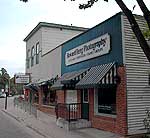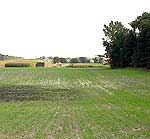By Dan Olson
Minnesota Public Radio
September 16, 2002
The dispute between the Metropolitan Council and Lake Elmo over the Twin Cities suburb's slow growth plan boils down to numbers - how many people might move in. Last week, the Met Council told the city it needs to accommodate more growth than the city is willing to accept. The Met Council predicts as many as 1 million more people will live in the Twin Cities in 30 years. The increase worries residents in Lake Elmo and many other communities, who are trying to preserve open space.
| |
|
|
|
||
We have met the growth enemy and it is us - and our sons, daughters, grandchildren, nieces and nephews. Some of the region's new residents over the next 30 years will be people from elsewhere. However most will be folks who decide to stay.
"Two-thirds of those will be people who are born here," Metropolitan Council commissioner Marc Hugunin says. "That growing population will clearly need places to live, places to go to work, to get a job. So the development pressure is pretty substantial throughout the region," Hugunin says.
Hugunin represents Lake Elmo and its larger and faster growing suburban neighbors, including Woodbury. Lake Elmo, with a population of 7,000, is 10 miles east of downtown St. Paul. It is bounded and bisected by busy roads - Interstate 94 on the south, Minnesota State Highway 36 on the north, and a county highway through the middle.
The epicenter of the dispute with the Met Council is Lake Elmo's southern border along Interstate 94.
| |
|
|
|
||
"The Met Council says, 'Oh no, you have to combine high density housing with apartments with lower cost homes,'" says Susan Dunn, a member of the Lake Elmo City Council. "I think that would definitely be a detriment to existing businesses."
Existing businesses, Dunn says, would be hit with big assessments for the expanded sewer service the Met Council says the area needs. Dunn says the other detriment would be building high density housing away from the original town of Lake Elmo, with its charming mix of stores and services.
"I think you'd be doing a disservice to plunk people out here on the freeway and expect them to be part of a community. and to feel part of the community," Dunn says.
Some say the community is opposed to higher density, less costly housing because it attracts lower income residents. But Dunn denies that. She points to the city's large mobile home park near the center of town as evidence of Lake Elmo's commitment to a mix of housing.
Met Council officials say compared to other cities, Lake Elmo's supply of existing affordable housing is small, and the city has no plans for allowing new affordable housing. Instead, Lake Elmo's housing mix is tilted toward large homes, on large lots ranging in size from two to 10 acres.
| |
|
|
|
||
However, city council member Steve DeLapp says a number of new developments have lots no larger than one-third of an acre. And Lake Elmo is nearly alone among the 197 other cities in the region to use an innovative plan to preserve open space.
The plan is called "cluster development," where homes are built relatively close together and future development, DeLapp says, is limited on the rest of the lot.
"The houses are put on half of the land. The other half is owned by either the original farmer, a homeowner's association, a city park in one case - with guaranteed protection from the Minnesota Land Trust or another organization, such as the city of Lake Elmo, that it'll never be developed," DeLapp says.
He says cluster development is the latest wrinkle in Lake Elmo's decades-old effort to preserve open space, and retain what many residents feel is the city's unique rural and small town character.
The Met Council's Marc Hugunin says he and other council members are charged by state law with overseeing the orderly and efficient economic development of the region. He says the most efficient pattern to follow is to encourage growth where services - such as roads - already exist.
"Where you have regional investment such as sewer, such as interstate freeway nearby - investment that the taxpayers have already spent their money to put in place - it makes sense that we would leverage those investments and that growth and development might occur close to where those already exist," Hugunin says.
The development drama onstage in Lake Elmo is being played out in dozens of other Twin Cities communities - and coming to many more as the region's population expands. They're all trying to preserve what drew people to them in the first place - open space and a small town feel.
More Information


